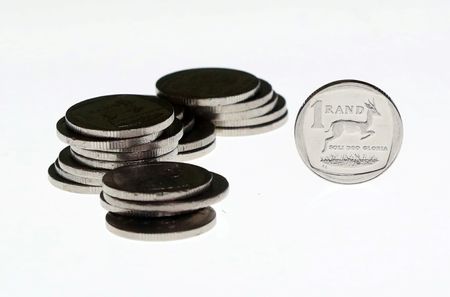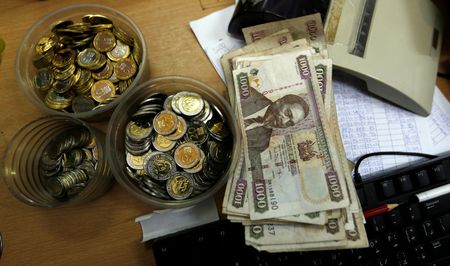By Amanda Cooper
LONDON (Reuters) – Global stocks tumbled on Monday, while the dollar traded at its highest in over two years, after last week’s blockbuster U.S. jobs data prompted traders to consider the possibility that the Federal Reserve may have finished cutting interest rates.
The December employment report on Friday showed 256,000 workers were added to nonfarm payrolls – well above expectations for a rise of 160,000 and the biggest increase since March.
Together with the growing expectations for inflation to pick up as a result of the policies on tariffs, migration and taxes of Donald Trump’s incoming U.S. administration, the jobs data delivered a blow to the view that rates have room to fall.
U.S. Treasury prices saw little respite from recent selling pressure, keeping yields near their recent peaks, while the dollar soared to its highest since November 2022 against a basket of major currencies.
The market is likely to be even more sensitive to Wednesday’s monthly inflation data, which could prove decisive in ruling out any more Fed rate cuts.
Stocks on Wall Street fell, taking their lead from weakness in Europe, where rate-sensitive sectors such as technology and financials weighed on the regional STOXX 600, which fell nearly 1%.
The S&P 500 lost nearly 0.9% in early trading, while the tech-heavy Nasdaq Composite fell 1.3%.
“The market is still in pullback mode. Bears dialed up the pressure last week, especially after Friday’s strong jobs report fueled concerns the Fed isn’t going to cut interest rates any time soon,” Chris Larkin, who is managing director of trading and investing at Morgan Stanley unit E*Trade, said.
A surge in energy prices added to investor unease over sticky inflation, as crude futures vaulted above $80 a barrel to their highest since August and U.S. natural gas futures hit two-year highs.
The U.S. swaps market shows traders barely see one rate cut this year from the Fed, with just 27 basis points priced in by December, down from closer to 43 bps ahead of Friday’s jobs report.
YIELDS PINNED AT HIGHS
Meanwhile, the Treasuries market, which witnessed a sharp selloff last week, remained under pressure.
Two-year Treasury note yields, which have risen 12 bps in the last week, were flat at 4.394%, while 10-year yields, which have risen by 16 bps since last Monday, were also unchanged around 14-month highs at 4.77%.
U.S. consumer inflation data for December is due on Wednesday and a Reuters poll of economists gives a median forecast for an annual rise of 2.9%, up from November’s 2.7% and for a monthly increase of 0.3%.
“Another hot print will likely only add fuel to the fire as to whether the Fed will need to re-engage with rate hikes later this year,” economists at BNP Paribas said.
The dollar, which is set for a fourth monthly rise in January, rallied broadly on Monday, sending the euro down 0.4% to $1.0207, near its weakest since late 2022, while sterling fell 0.47% to its lowest since early November 2023 at $1.2139.
In commodities, Brent crude futures were up 0.8% at $80.42 a barrel, wider U.S. sanctions on Russian oil and the expected effects on exports to top buyers India and China.
U.S. crude futures were up 1.2% at $77.52.
With U.S. yields and the dollar holding firm, gold fell 0.8% on the day to $2,667 an ounce. Gold generally struggles to compete for investor cash in a high-yield, high-dollar environment.
But the price hit a one-month peak last week, driven by uncertainty over Trump’s proposed politics on trade and the economy, as well as over rising energy prices.
(Reporting by Amanda Cooper; Editing by Ed Osmond)










